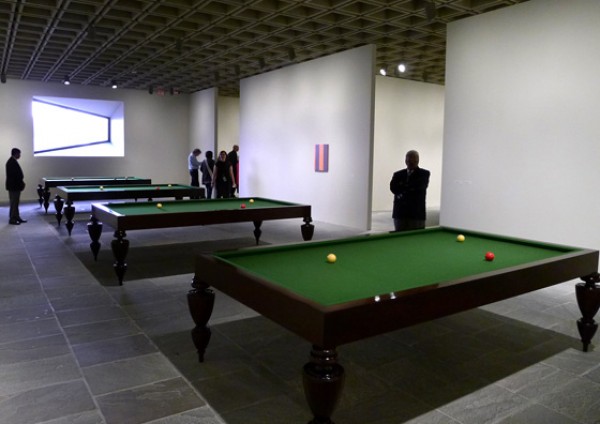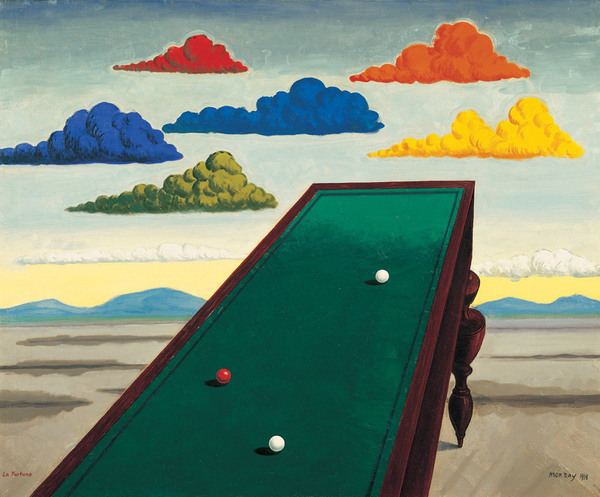
Sherrie Levine, “La Fortune” (After Man Ray: 4), felt and mahogany, 1990 (Whitney Museum of American Art, © 1990 Sherrie Levine)
Whitney Museum of American Art
945 Madison Ave. at 75th St.
Wednesday – Sunday through January 29, $18 (pay-what-you-wish Fridays 6:00 – 9:00)
212-570-3600
www.whitney.org
Walking through Sherrie Levine’s expansive “Mayhem” at the Whitney, one is overcome by a warm feeling of familiarity that is enhanced upon further examination of the unique conceptual world the American artist has created. For more than thirty years, the Pennsylvania-born Levine has been exploring ideas of ownership, gender, class, authenticity, and the creative process itself through painting, sculpture, photography, and installation. By reappropriating, repurposing, and recontextualizing existing imagery, often through dramatic acts of repetition, Levine brings up questions of artistic reproduction, art history, and how time and place influence perception. Taking works by Edgar Degas, Alfred Stieglitz, Piet Mondrian, Walker Evans, Marcel Duchamp, Gustave Courbet, Constantin Brancusi, and many others, Levine breathes new life into them, bringing them into the modern age and offering new ways to see them while wholly making them her own. For “After Walker Evans 1-22,” Levine photographed seminal WPA pictures taken by Evans and arranged them in a grid on the wall. For “Fountain (Madonna),” she cast a bronze urinal, combining Duchamp with Brancusi, and placed it in a vitrine to emphasize its artistic value. For the “Melt Down” series, Levine used a computer program to reproduce works by Mondrian, Monet, and Ernst Ludwig Kirchner, turned each into a monochromatic color field, and then filled canvases with that new color. In “La Fortune (After Man Ray),” she took a billiard table out of Man Ray’s “La Fortune” surrealist painting, creating four life-size replicas and placing them in a room, turning the Whitney into a pool hall. And in “Newborns,” Levine re-created a pair of Brancusi’s “Newborn” sculptures, one in black, one in white, and placed each on a grand piano, based on how she saw a Brancusi sculpture displayed in a photograph of a British collector’s home, bringing the private sphere into the public. “Mayhem” is not arranged as a chronological retrospective; instead, it forms a fascinating journey through the mind of an artist who lays bare the process behind her conceptual work, creating a very different kind of “group show” by a single artist.

Man Ray, “La Fortune,” oil on canvas, 1938 (© 2009 Man Ray Trust / Artists Rights Society (ARS), NY / ADAGP, Paris)
As a bonus, you can find Man Ray’s original 1938 “La Fortune” painting in the current “Real/Surreal” exhibit (through February 12), the second in the Whitney’s ongoing reexamination of its permanent collection as it prepares for its eventual move downtown. The exhibition also features works by Edward Hopper, Marsden Hartley, George Tooker, George C. Ault, Louis Guglielmi, Rockwell Kent, Charles Sheeler, Yves Tanguy, and others depicting scenes that are not quite as realistic as they might initially appear. Also at the Whitney right now are “Three Landscapes: A Film Installation by Roy Lichtenstein” (through February 12) and “Aleksandr Mir: The Seduction of Galileo Galilei” (February 19), in which the Polish-born Swedish and American artist attempts to reconstruct Galileo’s gravity experiments by building a tower with tires.